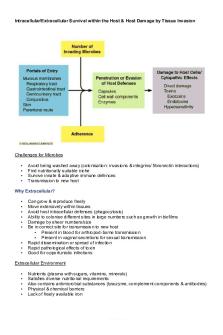Class Notes Host Factors PDF

| Title | Class Notes Host Factors |
|---|---|
| Course | Microbial Forensic Science |
| Institution | Syracuse University |
| Pages | 2 |
| File Size | 51 KB |
| File Type | |
| Total Downloads | 42 |
| Total Views | 150 |
Summary
Dr. James Crill...
Description
Host Factors ●
●
Host factors in microbial forensics ○ An underdeveloped and underutilized area in microbial forensics is how the host interacts with microorganisms in a way that provides unique signatures for forensic use. For forensic purposes, an immediate goal is to distinguish s potential victim and innocent person from a perpetrator, and to distinguish between a naturally acquired or intentional infection ○ What happens if the original evidence of a biocrime (cultures, vials, other specimens, etc.) are not available? ○ How can we tell the difference between a crime and an outbreak? Immunology Review ○ IgG ■ Most abundant antibody isotype in the blood (plasma), accounting for 7075% of human immunoglobulins (antibodies). ■ IgG detoxifies harmful substances and is important in the recognition of antigen-antibody complexes by leukocytes and macrophages. ■ Transferred to the fetus through the placenta and protects the infant until its own immune system is functional ○ IgM ■ Usually circulates in the blood ■ Accounts for about 10% of human immunoglobulins ■ Has a pentameric structure in which 5 basic Y-shaped molecules are linked together. ■ B cells produce IgM first in response to microbial infection/antigen invasion ■ Although IgM has a lower affinity for antigens than IgG, it has higher avidity to antigens because of its penameric/hexameric structure. ■ Activates cell signaling pathways by binding to cell surface receptors ○ IgA ■ Abundant in serum, nasal mucus, saiva, breast milk, and intestinal fluid ■ Accounts for 10-15 of human immunoglobulins. ■ Forms dimers (two IgA monomers joined together) ■ Break milk: protects the gastrointestinal tract of neonates from pathogens ○ IgE ■ Present in minute quantities ● Accounts for no more than 0.001% of human immunoglobulins ■ Original role is protect against parasites ■ In regions where parasitic infection is rare, IgE is primarily involved in allergy ○ IgD ■ Accounts for less than 1% of human immunoglobulins ■ May be involved in the induction of antibody production in B cells, but its exact function remains unknown
○
●
●
●
Consider a generic antigen exposure. The first time the immune system encounters antigen X (AgX), it responds with less antibodies ■ Intiallially, antibodies to AgX are barely discernible; then levels rise and later fall to a plateau. If a simultaneous exposure were to occur with AgX and a new AgY from another microorganism, the immune system would quickly mont a brisk response Response to Anthrax ○ The body's immune system initially detects the presence of anthrax spores by recognizing RNA molecules that coat the spore’s surface. But this prompts an unfavorable immune response that hinders the body’s fight against anthrax once the spores have germinated into live bacteria. Experimental model ○ Epstein - Barr virus (EBV), also know as human herpesvirus 4, is a member of the herpes virus family ■ One of the most common human viruses ■ Found all over the world ■ Most people are infected with EBV at some point in their lives. ■ Spreads most commonly through bodily fluids, primarily saliva ○ Infectious mononucleosis, AKA “mono” ■ Contagious ■ EBV is the most common cause of infectious mono, but other viruses can also cause this disease ■ Common among teenagers and young adults, especially college students. ■ At least one out of 4 teenafers and young adults who get infected with EBV will develop infectious mono For the clinician or epidemiologist, the antibody responses provide a framework to determine where in the course of the infection a patient may be. ○ Immunological response gives clues...
Similar Free PDFs

Class Notes Host Factors
- 2 Pages

Host Hardening - Brief
- 1 Pages

Git-host - sadd
- 3 Pages

Host manipulation by parasite
- 30 Pages

Class Notes
- 4 Pages

Class Notes
- 12 Pages

Class Notes
- 39 Pages

Pengertian Host Hardening
- 10 Pages

Succession Class Notes under JD Class
- 157 Pages
Popular Institutions
- Tinajero National High School - Annex
- Politeknik Caltex Riau
- Yokohama City University
- SGT University
- University of Al-Qadisiyah
- Divine Word College of Vigan
- Techniek College Rotterdam
- Universidade de Santiago
- Universiti Teknologi MARA Cawangan Johor Kampus Pasir Gudang
- Poltekkes Kemenkes Yogyakarta
- Baguio City National High School
- Colegio san marcos
- preparatoria uno
- Centro de Bachillerato Tecnológico Industrial y de Servicios No. 107
- Dalian Maritime University
- Quang Trung Secondary School
- Colegio Tecnológico en Informática
- Corporación Regional de Educación Superior
- Grupo CEDVA
- Dar Al Uloom University
- Centro de Estudios Preuniversitarios de la Universidad Nacional de Ingeniería
- 上智大学
- Aakash International School, Nuna Majara
- San Felipe Neri Catholic School
- Kang Chiao International School - New Taipei City
- Misamis Occidental National High School
- Institución Educativa Escuela Normal Juan Ladrilleros
- Kolehiyo ng Pantukan
- Batanes State College
- Instituto Continental
- Sekolah Menengah Kejuruan Kesehatan Kaltara (Tarakan)
- Colegio de La Inmaculada Concepcion - Cebu






